A quirky quote from Sir Arthur Conan Doyle, author of the Sherlock Holmes series, reads: “a man’s brain originally is like a little empty attic, and you have to stock it with such furniture as you choose.” Climbing the stairs to the fourth floor of Campus School, one enters swinging glass doors to find themselves in a different type of “brain-attic”– the SCCS library– overlooking the Campus School playground, Northampton rooftops, even a far-off mountain range. In its own way, the library is the brain of the building: colorful, joyful, welcoming. Over 20,000 books rest on its shelves; posters adorn its walls; students huddle over graphic novels at wooden tables, or curl up with their books in a crawl-space that is painted to look like Narnia. The rooms are not cluttered, but curated, “stocked” with literature that is “chosen” for its ability to affirm and expand readers’ worlds.
At the center of the space is Campus School librarian Emily Prabhaker, the children’s literature expert who composes this library as a place and a curriculum. Dedicated to making the library an “inclusive, welcoming place with many perspectives,” she brings to Campus School her prior experience as a Museum Educator at the Eric Carle Museum of Picture Book Art in Amherst, Massachusetts, where she worked to develop and present programs and workshops connecting the development of visual and verbal literacies in children.
During her daily routines at Campus School, Emily continues to utilize picture books as vehicles for sharing diverse perspectives with students. “I really love picture books because I feel like sometimes we think that they are only for kindergarteners,” Emily said, “but they are so complicated and [offer] so much.” It is for this reason that she incorporates them into library time: “In fourth grade, we just read Chef Roy Choi and the Street Food Remix. On one page, the character has an iPhone and is pinpointing places along a map where his food truck can go, bringing nourishment to all of these different neighborhoods, and the back matter is really good. We’re [using it] to think about research.”
In younger grades, Emily employs the “whole book approach,” a pedagogical method developed at the Carle by Megan Lambert:
“With kindergarten, I really start to lay the foundation for our library program by having an interactive story time once a week where we’re looking at the picture book as an art form, really encouraging kids to talk during the story time, to make meaning from what they’re seeing. In contrast to a passive story time where I’m performing and putting on this story and [students] are passively taking it in, I really want this story time to be a time when they feel like they are in the driver’s seat in terms of making meaning from the book, figuring out who’s telling the story, what’s going on, what story the pictures are telling, what story the words are telling, and how they, as readers, can put those two narratives together to make something in their minds.”
Why would a designer choose to make a book long and rectangular?, Emily might ask her students. Why is the picture under the jacket different from the one on the board? Why are the end pages designed and not just left white? “We really try to look at the whole book as an object,” she explained, “and to think constructively and collaboratively about what’s happening in these beautiful books.”
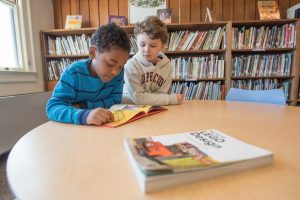
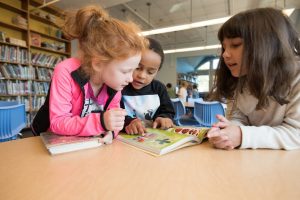
On a warm afternoon in late October, Emily greeted college students in education professor Carol Berner’s Methods of Reading course as they filled the Campus School library and settled amid stacks of storybooks. Having studied the #WeNeedDiverseBooks initiative prior to their visit, Smith College students were ready to engage in a discussion with Emily about the importance of diverse character representation in children’s literature, and to learn from her the multivalent role that picturebooks have in classrooms. “Emily modeled for my students how the whole book approach shifts responsibility for making meaning from the adult to the child: making readers (in this case, my students) active participants in developing theories, challenging each others’ interpretations, and examining every element of picture book design – even taking a ‘library peek’ under the jacket,” said Professor Berner while reflecting on her class’s visit. “She also raised new perspectives for my students about inclusion and diversity in children’s literature, from gaps in publishing trends to highlighting ‘own voices’ authors. Examples of her classroom work gave students opportunities to see how diverse children’s picture books can inform and transform every aspect of the curriculum.”
Highlighting ‘own voices’ authors– authors who identify with a marginalized group that their main character also identifies with– is a goal that Emily brings to life, not only through the texts that she chooses to share with young readers, but through the stories of real-life authors. Last year, for example, Emily welcomed children’s book author Grace Lin to Campus School– an experience that had a lasting impact on students:
“Grace Lin came to visit for [a] whole day and saw everybody,” said Emily. “It was really amazing, and even though I knew that it was going to be a rich and meaningful experience, hearing the students process her visit after, and hearing about how important it was for them, and thinking about their different favorite moments was incredible. I had them write down their favorite moments on a notecard, and one student said ‘She held the door for me when I got to school!’ And that’s a moment you really take with you. It teaches students to not take for granted books as just sitting on shelves, but being created by real people. We had students who really valued what Lin had to say about being one of the only Asian kids in her school growing up, and that was an experience that really came through for them in her books: that she was able to say that and get through that—having that be a hard feeling, and then being able to make art out of it—was a really valuable message. Her visit made me think about the power of author visits, and author visits that share a perspective we may not hear as much from.”
Motivated by Lin’s impact, Emily joined with fourth grade teacher Tiphareth Ananda to apply for an Inclusion Grant from the College, which they were awarded in early November. The funding will allow Emily and Tiphareth to bring to Campus School more children’s authors whose works portray a breadth of identities and lived experiences.
In the way that she inspires young readers through live connections with authors, Emily also shapes her curricula to highlight another link in the chain of creative development: the provocations and inspirations that children’s book authors had when they were young. Second graders, for example, think about artistic inspiration by studying the books and artwork that children’s book authors enjoyed as children. “It’s so cool because I then think of my students and how [what we’re reading together] is informing their own developing aesthetics and world-views,” said Emily:
“Yesterday we were talking about the artist Jerry Pinkney, who has many beautiful picture books—some wordless, some adaptations of Aesop’s fables, all really beautiful watercolors. We looked at this image ‘Marigolds’ by Leonard Baskin,” whose grandchildren went to Campus School. “Jerry Pinkney saw ‘Marigolds’ in an art gallery when he was really young but didn’t have any money to buy art. However, he felt like he had to have this piece of art, so he put it on layaway. The gallery let him pay just five dollars a week. We looked at that image, which is this darkish, gold plant hanging… and at Pinkney’s end papers in his book. The kids were able to [discover] that green leaves go all the way out to the edges, similar to Baskin’s piece. The idea of something sparking inspiration in you that then informs your life’s work is just so exciting.”
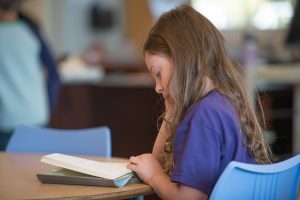
Hanging on the wall adjacent to Emily’s desk, between encyclopedias and nonfiction books, is a Reading Without Walls poster designed by Gene Luen Yang, author of the acclaimed graphic novel American Born Chinese. “He was the National Ambassador for Young People’s Literature last year,” Emily said while looking at the image, “and he had a campaign about reading books about people who don’t live like us, or don’t look like us, and that’s something that I’m really trying to instill in students through author visits, and through the books that we have: stretching the boundaries of our reading lives and the perspectives that we tend to take in when we go to certain authors’ shelves– opening the idea of children’s books as both mirrors of readers and windows [to the world].”
Because connecting students with the world through literature is an active pursuit at Campus School, Emily challenges the trope of quiet library time by engaging students with curricular approaches such as project-based learning. Second graders will soon begin a unit on picture books written about female architects: One book will profile Maya Lin, who designed the Vietnam Veterans Memorial in Washington, D.C. and is currently designing the new Smith College library. Another, The World is Not a Rectangle by Jeanette Winter, is a picture book about Zaha Hadid, who constructed inventive building structures—round, long, tall buildings that appeared impossible to many other architects. Because Lin and Hadid were both inspired by nature, Emily will then incorporate design-thinking strategies into her curricula by scaffolding students’ creation of their own nature-based buildings. Last year, children designed chairs shaped like seaweed; airplanes like fish; a hotel like a bird—“a flying bird, but you stayed in it as a hotel”—and used materials like cardboard and construction paper to bring their ideas to life. “To see the ideas that are sparked by these books is just beautiful,” Emily reflected.
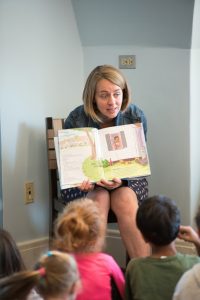
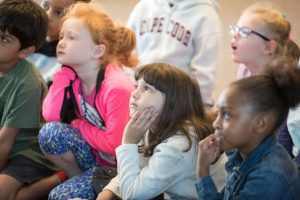
In later grades, Emily keeps students moving by using a lockbox from Breakout EDU, the curricular opposite of an “escape room.” Instead of solving puzzles to break out of a room, as in the popular gaming businesses found around the country today, students instead answer questions to break in to a box filled with prizes. Last year, fifth and sixth graders answered library trivia (about the Dewey Decimal system, for example) to win a hundred dollar gift certificate that they spent on library resources. This year, they will study a book about Katherine Johnson, one of the scientists in the movie Hidden Figures, who saved Apollo 13. Throughout the rest of the year, students will create book talks and movie trailers; write book jackets, descriptive blurbs or reading journals.
Underpinning Emily’s lively activities is a focus on library stewardship. Older students’ winning a gift certificate to allocate for library resources fosters a sense of leadership and ownership that begins early-on at Campus School:
“First graders like learning to be borrowers,” Emily said. “Every single library time we have a good, solid chunk of time for browsing. Students might be in a corner around Lego books thinking ‘How can we make these things at home?’; students might be on the couches reading about what happens at the very bottom of the ocean; students might be finding graphic novels and reading them all in one sitting before they can even check them out; scrolling to find books they haven’t read yet; trying to find books that we have two of so they can read them in a pair. Sometimes during that browsing time students are listening to audiobooks that I might have loaded on an iPad. We have the nonfiction room and the fiction room, so there’s a lot going on during browsing.”
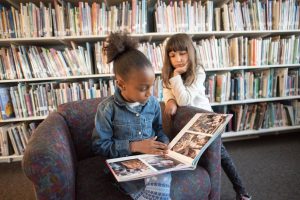
In a cultural moment when readers and authors around the world are compelled to write in defense of libraries (see Zadie Smith’s “The North West London Blues,” a nuanced analysis of the state of her local UK libraries featured in New York Books and revised for her new essay collection Feel Free; Margaret Atwood’s letter published on the New York Public Libraries website; or Neil Gaiman’s assertion that our future depends on “libraries, reading and daydreaming”), the balance between Emily’s emphases on enjoyment and responsibility in the Campus School library carry heightened resonance. Atwood describes libraries as “a place for minds to meet minds and hearts to move hearts.” Creating space for this type of connection by offering both guidance and freedom of choice– true to the “whole book approach”– Emily affords students the agency, to recall Doyle’s words, to “furnish” their minds as they wish, learning with and from characters, authors, and peers.
In her children’s book When the Sea Turned Silver, visiting author Grace Lin wrote: “[S]tories are how we share our lives and what we truly mourn when they are lost. Stories are what connect us to our past and carry us to our future. They are what we cherish and what we remember.” With that ethos in mind, the Campus School library is a place where students and teachers access stories from around the world and, in turn, learn to share stories of their own. To see how one Campus School alumna chose to share her stories, check out our Q&A with best-selling novelist Jenn duBois ‘96.
Written by Brittany Collins.
.
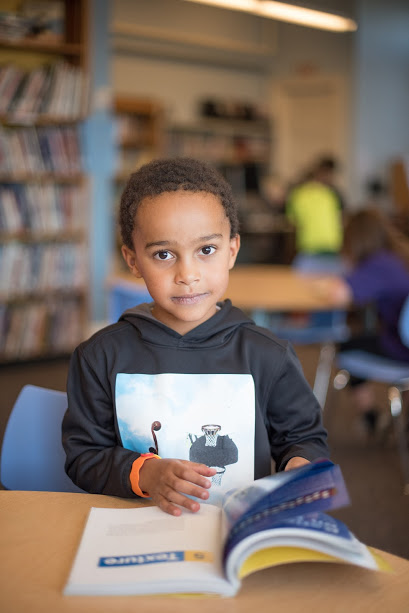
Comments are closed, but trackbacks and pingbacks are open.